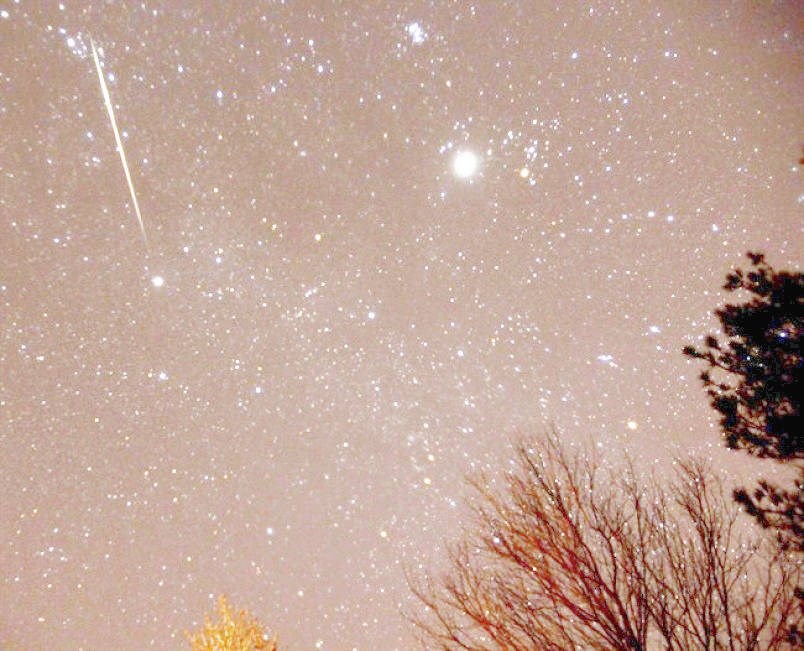If it is clear and you don’t mind bundling up, head outdoors after dark and turn your face skywards. Wait for a few minutes for your eyes to adjust.
You just might catch a falling star.
OK, not a star. But you may catch sight of asteroid gravel streaking through the upper atmosphere in small blazes of glory.
The Geminid meteor shower peaks tonight and tomorrow morning and is considered by many skywatchers to be the finest of the meteor showers.
This year — clear skies permitting — the viewing will be better than usual. A new moon will ensure dark skies, increasing our chances of seeing up to 150 shooting stars per hour.
When comets and asteroids careen through space on their own special orbits, they each leave behind them a trail of their own dust, debris, ice, pebbles and so on — much like the trails of cookie crumbs, dandruff, hair, skin particles, mites, viruses, bacteria and so on that we each leave in our own wake, no matter how often we bathe, brush, polish, pluck and so on, whether we admit to it or not.
Meteor showers occur when Earth, in its orbit around the sun, crosses those debris streams. The space “bits” enter our atmosphere at enormous speeds, often tens of kilometres per second — far too fast for air to be pushed out of the way. The air in the bow wave before the pebble compresses heats up instantaneously and ionizes into plasma. This incandesces at temperatures hotter than several thousand degrees. The heat transfers into the meteoroid, and there you have it — great flashing fizz, followed by fizzle.
Most meteor showers consist of dust, pellets and ice from comets — giant, dirty Frosty the Space-snowballs.
The Geminids, however, are the traces of an asteroid, likely a small one called 3200 Phaethon. This means the particles pinging our atmosphere this week are pebbles and rocks. When the gravel bits hit the atmosphere and blaze up, they don’t fizzle as quickly as Frosty’s crumbs do. They last longer, and the burning minerals make for colourful pyrotechnics — reds, greens and even blues.
There’s even a chance a fireball will occur, like the one that streaked over the Lower Mainland in August, during the Perseid meteor shower. The Perseid shower is associated with the debris stream of comet Swift–Tuttle.
Meteor showers are named for the constellations they appear to come from. The Geminids appear, from our perspective, to radiate from the constellation Gemini. Likewise, the August Perseids appear to come from the constellation Perseus.
But the Geminids are the first of December’s sky events coming our way this year. Just as this light show winds down this week, another begins.
The Ursid meteor shower, which appears to come at us from the Little Dipper or Ursa Minor, lasts from about Dec. 17 to 26, and peaks around the solstice. This is a much lower-key light show than the Geminids are, offering just five to 10 meteors per hour before dawn. With a first-quarter moon, viewing should still be good if the weather co-operates.
If that’s not enough to lure you from a cozy sofa and The Queen’s Gambit, perhaps another solstice-sky event will entice you.
On Dec. 21 (skies permitting), you can witness an Extra-Special Great Conjunction.
Just after sunset on the solstice, towards southwestern horizon, Jupiter and Saturn will appear to merge into their own planetary pas de deux.
The last Great Conjunction (you can thank astronomers of yore for the term and its initial caps) occurred 20 years ago. However, this year’s Great Conjunction is Extra Special (hats off to the Royal Astronomical Society of Canada’s Vancouver chapter for the compound adjective and its initial caps), because these two gassy giants haven’t got this cosy with one another since 1623. Kings James I of England and Louis XIII of France, and many First Nations across what is now Canada, may have watched that earlier planetary minuet.
Now that’s Extra Special.
And Great.
May you have clear skies this month.



